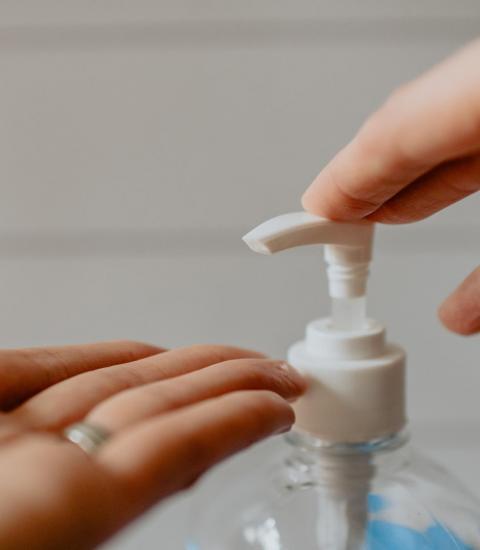
Hand sanitiser is poisonous?
Alcohol based hand sanitiser (ABHS) either contains ethanol or isopropanol, which can denature proteins and inactivate viruses [1]. These ingredients inactivate COVID-19 if it is present on our hands.
If ABHS comes into contact with mucous surfaces, such as our eyes, then it can cause intense pain, redness of the conjunctiva, damage to the corneal epithelial cells, and loss of vision [1, 2].
If ABHS is swallowed it can cause vomiting, convulsions, and death [3].
For these reasons, ABHS usually carry warning labels on the packaging, for example, keep out of reach of children, or instructions to contact a poisons information line or a health care professional if the product is swallowed.
Cases reported in the medical literature
There have been several papers published in the medical literature describing incidents where a child swallowed or had ABHS splash into their eyes. For example:
- McCulley and co-authors [3] report there were 4451 contacts with the American Association of Poison Control Centres during the period of January 2020 to April 2020 because a child younger than 5 years had ingested ABHS or had splashed ABHS into their eyes.
- Hanna and co-authors [4] describe an incident in Australia where a 6-year old girl drank about 50mL of ABHS because she liked the smell and taste of it. She was hospitalised for 24 hours.
- Martin and co-authors [5] reviewed cases reported to the French Poison Control Centres between April 2020 and August 2020. They discovered 232 instances of ABHS splashing into the eyes of a child (mean age 4.5 years old). This had increased from 33 cases reported during April to August 2019.
- Yangzes and co-authors [2] describe two cases in India, a 4 year old girl and a 5 year old boy, who needed medical treatment after being accidentally splashed in the eye with ABHS.
- Rodriguez-Ares and co-authors [1] describe a 3 year old boy in Spain who was accidentally splashed in the eye with ABHS and who subsequently required eye surgery.
Why are children more at risk?
There are two main reasons children are more at risk:
- ABHS may be coloured, perfumed or contain essential oils to increase its attractiveness as a product. Children could mistake it as a drink or food [3].
- ABHS is usually placed in prominent locations to remind people to use it on their hands. Waist/hand height for an adult is eye-height for a child, so when someone accesses the ABHS, it can easily splash into the eyes of a child.
How can we protect children?
There are calls within the medical literature to:
- Change the package design so that it is childproof [4].
- Improve the packaging so it is less likely to accidently splash [1].
- Make the product taste bitter [4] or smell unattractive [4].
- Not put ABHS within reach of children [4, 6].
- Place ABHS for use by children (or small stature adults) at a lower hand height [2].
- Train children how to use ABHS safely [2].
- Advise adults to assist children when they use ABHS [2].
- Install signage and caution signs next to ABHS dispensers [2, 5, 6].
- Use soap and water instead of ABHS [2]
What should you do if a child swallows hand sanitiser or has hand sanitiser splash into their eyes?
If a child swallows ABHS then contact your local poisons information line for guidance, or take the child to a health care professional [3].
If a child gets ABHS in their eye, flush their eye with saline or water, and then take the child to a health care professional [6].
References
1. Rodriguez-Ares, M., et al., Hand sanitiser-associated ocular chemical injury in children. Journal of Pediatrics and Child Health, 2021. DOI:10.1111/jpc.15395.
2. Yangzes, S., et al., Hand Sanitiser-Induced Ocular Injury: A COVID-19 Hazard in Children. JAMA Ophthalmology, 2021. DOI: 10.1001/jamaophthalmol.2020.6351.
3. McCulley, L., et al., Alcohol-based hand sanitizer exposures and effects on young children in the US during the COVID-19 pandemic. Clinical Toxicology, 2020.
DOI: 10.1080/15563650.2020.1811298.
4. Hanna, S., K. Zwi, and D. Tzioumi, Morbidity in the COVID-19 era: Ethanol intoxication secondary to hand sanitiser ingestion. Journal of Pediatrics and Child Health, 2020. DOI: 10.1111/jpc.15017.
5. Martin, G., et al., Pediatric eye injuries by hydroalchoholic gel in the context of the coronavirus disease 2019 pandemic. JAMA Ophthalmology, 2021.
DOI: 10.1001/jamaophthalmol.2020.6346.
6. Colby, K., Unintended consequences of hand sanitizer use in the coronavirus disease 2019 pandemic. JAMA Ophthalmology, 2021.
DOI: 10.1001/jamaopthalmol.2020.6327.
Title Photo by Kelly Sikkema on Unsplash
Jennifer Long is a visual ergonomics consultant based in Sydney, Australia, www.visualergonomics.com.au
